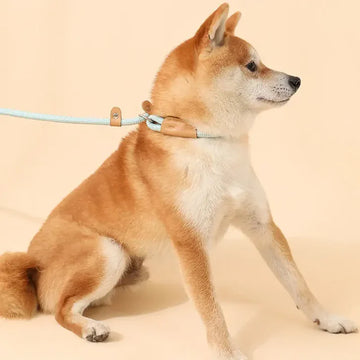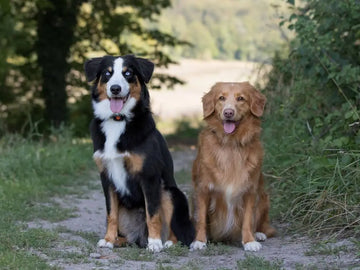If you're wondering whether to choose a collar or a harness for your puppy, you're not alone. Every puppy owner faces this decision, and the right choice depends on your puppy’s behavior, size, and specific needs. Both collars and harnesses serve important roles, but each has distinct advantages and drawbacks. Understanding these differences can help you decide what’s best for your furry friend, ensuring their safety, comfort, and training success.
The Case for Collars
Collars are a classic option for dogs and remain one of the most convenient tools for puppy owners. They’re lightweight, simple to use, and perfect for holding ID tags. For many dogs, a collar is their first accessory, making it a natural choice for new puppy owners.
Advantages of Using a Collar
- Convenience: Collars are easy to put on and take off, making them ideal for everyday wear. This is especially useful if your puppy is still getting used to wearing accessories.
- Identification Tags: A collar offers a secure place to attach ID tags with your puppy’s name and contact information. This is essential in case your puppy ever gets lost.
- Training Starter: While harnesses are often better for leash training, collars can still work for calm puppies who don’t pull excessively.
Limitations of Collars
Despite their benefits, collars aren’t suitable for every situation or puppy. For breeds with delicate necks or puppies that pull on the leash, collars can cause strain or injury. Persistent pulling can lead to discomfort, behavioral issues, and even long-term damage to the trachea in small breeds. Collars also don’t provide the level of control needed for active puppies, making leash training more challenging.
The Case for Harnesses
Harnesses are increasingly popular, especially for puppies. They distribute pressure evenly across the chest and back rather than concentrating it on the neck, making them a safer option for many dogs.
Advantages of Using a Harness
- Improved Control: Harnesses provide better leverage over a puppy’s movements, especially during training sessions. This is crucial for energetic or larger breeds.
- Safety and Comfort: By avoiding pressure on the neck, harnesses help prevent injuries like tracheal collapse. They’re particularly important for small or brachycephalic breeds, such as French Bulldogs, which are prone to respiratory issues.
- Pulling Prevention: Front-clip harnesses discourage pulling by redirecting the puppy toward you when they try to lunge forward.
- Escape Resistance: Properly fitted harnesses are harder for a puppy to slip out of, providing extra security during walks or outings in busy areas.

Potential Drawbacks of Harnesses
Despite their many benefits, harnesses are not without challenges. They can be bulkier than collars, which may make some puppies resistant to wearing them at first. Additionally, they take more time to put on and adjust compared to collars. Puppies left unsupervised might chew on the straps, particularly during their teething phase, so it’s essential to monitor them closely.
When to Use a Collar or Harness
The decision to use a collar or harness depends largely on your puppy’s individual needs and lifestyle. While collars are practical for everyday use, harnesses often provide the control and safety required during walks or training.
Situations Favoring Collars
- Your puppy doesn’t pull excessively on the leash and behaves calmly during walks.
- You need a lightweight option to hold ID tags.
- The outings are short and don’t involve high-energy activities.
Situations Favoring Harnesses
- Your puppy is excitable, pulls on the leash, or is still learning to walk calmly.
- You have a small breed or a puppy prone to neck or respiratory issues.
- You’re focusing on leash training and need better control to redirect behavior.
- Safety is a priority, such as during long walks, hikes, or crowded areas.
Why Not Use Both?
Many dog owners find that combining both a collar and a harness is the most effective approach. A collar can remain on your puppy for identification purposes throughout the day, while a harness can be used during walks or training. This ensures both convenience and safety without compromising on your puppy’s comfort.
When walking your puppy, pairing a harness with a high-quality leash is essential. Look for dog leashes that are durable, comfortable to hold, and easy to attach to your chosen gear. Using the right leash enhances your control, especially during training sessions.
Training and Safety Considerations
Proper training and safety practices are critical regardless of whether you choose a collar or harness. Here’s how to ensure your puppy’s experience is positive and secure:
Fitting Your Puppy Correctly
- Two-Finger Rule: Whether it’s a collar or harness, you should be able to slide two fingers between the strap and your puppy’s skin to ensure a snug but comfortable fit.
- Adjust for Growth: Puppies grow quickly, so check the fit regularly to avoid tightness or discomfort.
- Monitor for Irritation: Inspect your puppy’s neck and chest areas for signs of rubbing or chafing.
Training with a Harness or Collar
For leash training, harnesses are generally more effective, especially front-clip designs that discourage pulling. Use treats and positive reinforcement to help your puppy associate wearing the harness or collar with pleasant experiences. Start training in quiet, distraction-free environments before moving to busier areas.
Making the Right Choice
Ultimately, the choice between a collar and a harness will depend on your puppy’s specific needs and your lifestyle. For identification purposes and short, low-impact outings, a collar is a simple and effective solution. For longer walks, training, or puppies prone to pulling, a harness offers the safety and control you’ll need.
Investing in best dog supplies, such as a well-fitting harness, ensures your puppy’s comfort and safety during every adventure. Pair this with a durable leash, and you’ll have a setup that supports your puppy’s growth and training while keeping them secure.
Whether you opt for a collar, harness, or both, providing your puppy with the right gear lays the foundation for a happy and well-behaved dog.









